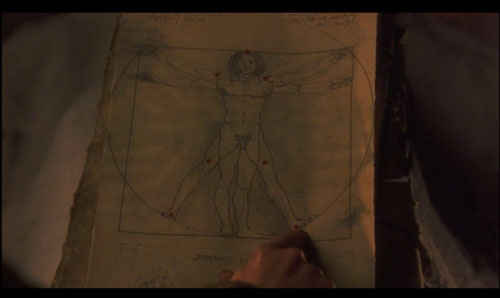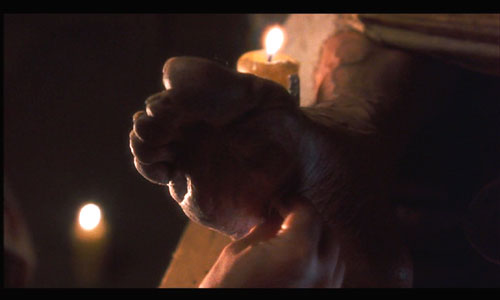
| welcome | ||||||||||||||
| history | ||||||||||||||
|
||||||||||||||
| reconstruction | ||||||||||||||
| today | ||||||||||||||
|
||||||||||||||
| links | ||||||||||||||
| about this site |



Many appropriations of the Vitruvian man utilize him as representative of mankind, in general, or of the perfect man. After all, he is often called "The Universal Man." Two particularly potent examples come from recent films: in the 1994 film Mary Shelley's Frankenstein, Victor Frankenstein uses the Vitruvian man as a model as he fashions new life, and the 1997 Contact uses a stylized Vitruvian Man to represent man to the cosmos.
As Victor Frankenstein puts the finishing touches on his creation in the
1994 film Mary Shelley’s Frankenstein, he glances at a reproduction
of the Vitruvian Man. On this diagram, several key points have been marked,
which Frankenstein proceeds to reproduce on the body of his figure. His quest
is the creation of the perfect man and a new life, and in this quest he imitates
the “Universal Man”.
 |
| Source: Mary Shelley's Frankenstein, dir. Kenneth Branagh, 1994. |
 |
| Source: Mary Shelley's Frankenstein, dir. Kenneth Branagh, 1994. |
What does the use of the Vitruvian Man as the model for Frankenstein’s
monster indicate? A full analysis is well beyond the scope of this website,
but a few speculations are presented below:
The producers simply needed a diagrammatic, proportional image for Frankenstein
to use a model, and “that one in the circle” was the first that
came to mind
Frankenstein is playing God. The Vitruvian Man is His own image. The
Vitruvian man is…Adam? Jesus?
Frankenstein, in his own words, seeks "a combination of ancient
wisdom and new knowledge." The Vitruvian man himself embodies this
combination, as an ancient idea of Vitruvius’ embodied in a scientific
Renaissance rendering
The Vitruvian Man is also a prominent image in the office of Frankenstein’s
mentor, Professor Waldmann. When Waldmann is killed by a transient, Frankenstein
steals his notebooks in order to continue his work. Perhaps it is in tribute
to the knowledge of his mentor, as well as to that of the ancients, that
Frankenstein uses the Leonardo’s drawing as his model man.
Additionally, there do seem to be parallels between Frankenstein and Leonardo himself. Both lived, as the introduction to the film reads, in "a world on the brink of revolutionary change…the quest for knowledge has never been greater. Alongside political and social upheaval, scientific advances that would profoundly change the lives of all." Both were passionate about investigating the body of man – Frankenstein in order to create anew, and Leonardo in order to understand the body and its relation to the cosmos. Both were passionate, scientific, driven men. Perhaps these parallels also contributed to the selection of "The Vitruvian Man" as Victor Frankenstein's model for his creation.
In the movie Contact, the human race has a close encounter with that of extra-terrestrial life. And what better to use as inspiration of the logo of the international space agency that is to be involved in making a 50-light year journey? You guessed it. Here, we see a logo clearly inspired by the Vitruvian Man symbolizing not any particular aspect of humanity, but humanity in and of itself.
|
|
| source: Contact, 1994, dir. Robert Zemeckis |